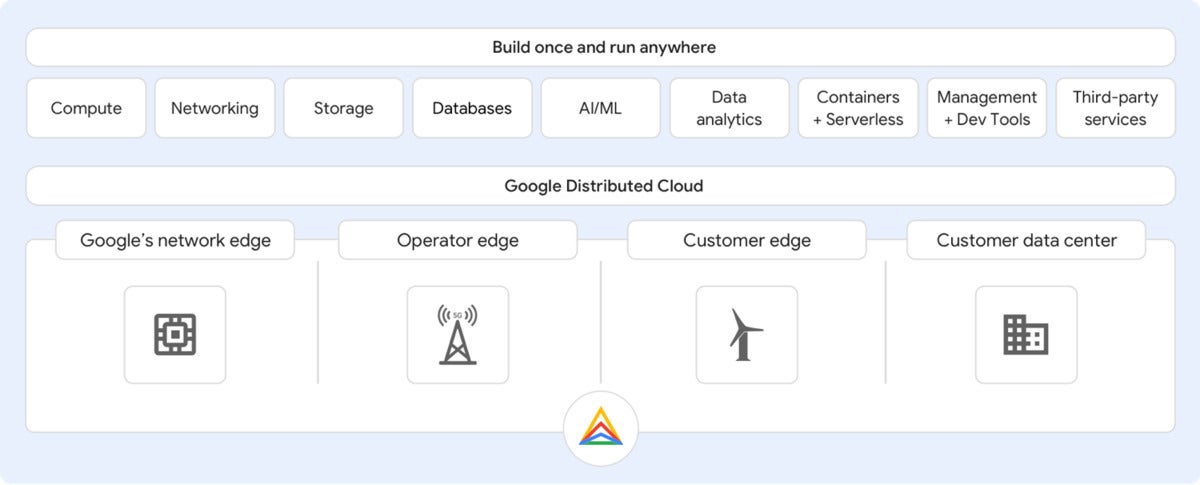- Kali Linux gets a UI refresh, new tools, and an updated car hacking toolset
- How the Sandwich Generation Can Fight Back Against Scams | McAfee Blog
- Buy a Samsung Galaxy Watch 7 on sale and get a free SmartTag2 Bluetooth tracker - here's how
- Cisco capitalizes on Isovalent buy, unveils new load balancer
- I upgraded to Android 16 - here's what I love and what's still missing
Google Cloud extends its reach with new Distributed Cloud options

Google Cloud is extending its reach into customers’ data centers and out to the edge under its new Distributed Cloud banner, primarily aimed at customers with unique data sovereignty, latency, or local data-processing requirements.
The two new options announced this week are Google Distributed Cloud Edge and Google Distributed Cloud Hosted. Both are underpinned by Google Cloud’s Anthos product, which allows customers to deploy and manage Kubernetes workloads across a variety of environments.
 Google Cloud
Google Cloud“Google Distributed Cloud is a portfolio of fully-managed software and hardware to extend our capabilities into customer data centers,” Sachin Gupta, VP and GM for open infrastructure at Google Cloud said during a press conference last week.
The hardware will come from a set of launch partners such as Cisco, Dell, HPE, and NetApp, and the software is underpinned by the open source container orchestration tool Kubernetes, which originally emerged out of Google in 2014.
Together, this brings Google Cloud further in line with its rivals AWS and Microsoft Azure in offering customers more choice over how and where they run and manage enterprise workloads.
“The move is a solid shot over the bow of both Microsoft’s Azure Arc proposition, and AWS Outposts,” Nick McQuire, an analyst at CCS Insight told InfoWorld, via email.
What is Google Distributed Cloud Edge
The first of these is Distributed Cloud Edge, which allows customers to run applications across Google’s 140-plus global edge locations, partnering telecoms’ operator environments, their own data center or colocation facility, and edge locations such as a factory floor, all while leveraging Google’s various data processing and analytics capabilities closer to where that data is generated and consumed.
This is aimed at applications which require low-latency at the edge, have local data processing requirements that can’t be met by the public cloud, or for emerging private 5G or LTE workloads.
Google extending its capabilities to the edge fits into a broader trend among cloud vendors who want to allow customers to connect a growing range of devices—from sensors on the factory floor, to a variety of sensors on industrial devices—into a central hub where workloads can be managed consistently.
“The unique benefit public cloud edge computing offers is the ability to extend underlying cloud architecture and services, particularly for customers already heavily invested in one public cloud or another,” my colleague Isaac Sacolick wrote. “Do architects and developers want to leverage AWS, Azure, or Google Cloud services deployed to the edge? That’s what the public clouds are betting on—and they are also considering 5G-enabled mobile applications that require low-latency data and machine learning processing at telco endpoints.”
Google has somewhat lagged its rivals in this space, but has been making moves to close that gap recently. This included a concerted effort with the launch of Anthos for telecom, partnerships with AT&T, Nokia, and Ericsson on 5G connectivity, and the Google Mobile Edge Cloud.
Distributed Cloud Edge is available in preview immediately.
What is Google Distributed Cloud Hosted
The second option, called Distributed Cloud Hosted, is primarily aimed at customers who need to operate in a hybrid model and have strict local requirements or particularly sensitive workloads. It promises a route to modernize on-premises deployments by accessing Google Cloud services via a set of consistent APIs, but without direct connectivity to Google Cloud.
“We offer this as a hosted option to run in their own data center for low-latency, resiliency, and confidentiality requirements,” Google Cloud CEO Thomas Kurian told InfoWorld.
In terms of how this differs from running Google Kubernetes Engine (GKE) on-premises through Anthos, Gupta explained that it comes down to the control plane. When clusters are “on-premises or hosted, it is exactly the same Kubernetes but with a local control plane [provided via Anthos], so Distributed Cloud relies on a fully local control plane,” he said.
Future updates will be published by Google Cloud using a dedicated secure repo, where the customer can scan and validate them themselves before carrying them over the air gap to apply to their local environment.
This builds on an announcement Google Cloud made last year around its data sovereignty commitments. “At Google Cloud, we take these issues—often discussed under the umbrella term of digital sovereignty—seriously. We are working diligently across three areas: data sovereignty, operational sovereignty, and software sovereignty, to help address digital sovereignty in the cloud computing context. And we continue to listen to customers and policymakers and incorporate their feedback on the best potential path forward,” CEO Thomas Kurian wrote at the time.
Distributed Cloud Hosted will be not be available in preview until the first half of 2022.
Copyright © 2021 IDG Communications, Inc.

